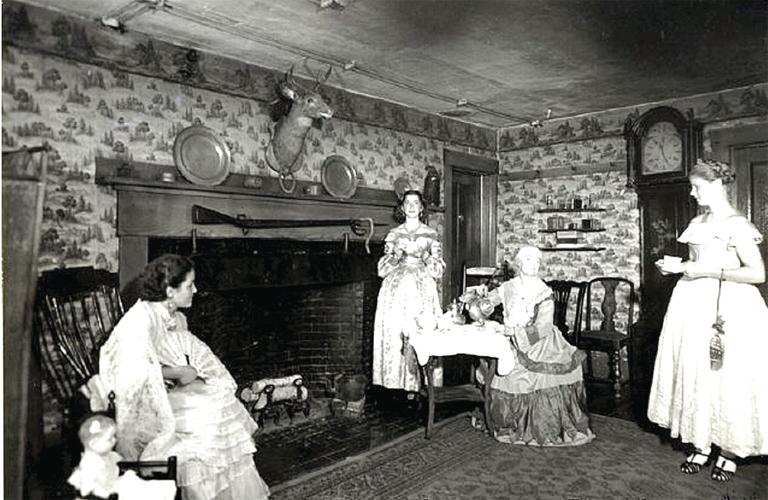LACONIA — If only these walls could talk.
Josh Youssef has wondered about that quite often since 2011 when, on an impulse, he bought the oldest house in Laconia.
“I was able to be in the midst of the entire history of the United States,” Youssef said about the so-called Jewett House, located at 42 Gilford Ave. “I occupied the same space where there were so many conversations – conversations about the foundation of the country.
As a matter of fact, Youssef’s house was built by Jacob Jewett, who fought in the Revolutionary War.
The 1½ story, center chimney cape-style house was built in 1780 in what then was part of Gilford.
It remained in the Jewett family well into the middle of the 20th century. And considering that the Jewett family was known for their involvement in politics, it’s a pretty sure bet that every pivotal moment in the country’s history was discussed at length within the house’s walls.
One of the house’s nicer amenities was a cotton-damask tablecloth that once belonged to Meshech Weare, the first governor of the state, and which Weare used when George Washington and General Lafayette visited him in Hampton Falls, according to an article written by Abby Jewett Austin — which appeared in the Laconia Democrat in 1936.
Abby, Jacob Jewett's great-granddaughter, was the last of the Jewetts to live in the house. She was an art teacher at Laconia High School and ran a tea room at the house prior to her death in 1944. Even as late as the time Abby was living there, Jacob Jewett’s Revolutionary War musket hung suspended from the fireplace mantle.
It was this sense of history which captivated Youssef when he first walked into the Jewett Homestead back in 2011 after a bank had foreclosed on the property.
Despite its dilapidated condition, Youssef saw its charm. On impulse he told the real estate agent to make a cash offer “with no contingency and no home inspection.” The agent tried to talk him out of making such an open-ended offer, but he insisted. In the end he paid $67,000 for the house — with all of his history, all of its charms, and all of its challenges.
Youssef spent much of the next six years embarking on a series of repair and renovation projects. Despite the house’s sturdy timber frame, mortise and tenon construction, it needed a tremendous amount of work to make it livable — new roof, new heating system, new plumbing, new insulation.
The original part of the house has 14 rooms and three bathrooms. An ell, which was added around 1840, has what is now a workshop on the first floor and an in-law apartment above it. Alongside the house was a substantial barn, which was dismantled and trucked to Gilford in the 1990s, where it was rebuilt.
With so much major work needed make the home livable, Youssef did not move in until 2013. Thereafter he spent the next 2½ years on a series of projects. He stripped the paint off the wide pine board flooring throughout the house and then stained and varnished it back to its original appearance. In one part of the ell, Youssef ended up removing eight layers of floor covering.
“I felt I was removing an epoch of history with each layer,” he chuckled.
While Youssef says he was sensitive to the house’s history he also wanted to make the home practical for 21st century living.
“It’s a time-period renovation, not a restoration,” he explained.
For example the kitchen has a center island and granite countertops, neither of which would have been found in 1780s New England homes.
“I wanted the home to have modern functionality while still retaining its charm and majesty,” Youssef said.
As Youssef worked his way through the renovation process he came across paintings and pencil sketches on some doors and other pieces or woodwork, which have been preserved.
He estimates all the renovation work amounted to about $200,000 — three times what he paid for the house.
Youssef continues to own the house, but moved out of the Jewett Homestead about four years ago because its location — set back just feet from busy Gilford Avenue — was not a good fit for his young and growing family.
“I now live in a more conventional neighborhood, in a house that’s less than 30 years old,” he said.
The saying they don’t make them like they used to certainly applies to the Jewett Homestead. It was built to last, according to what Abby Jewett Austin wrote back in 1936:
“A large cornerstone (of the chimney) measures 9 feet in length. It would seem that this and the foundations of the house were laid for posterity, for the sills of the house comprise two timbers laid parallel all around the stone foundation and 6 inches apart. … It is perhaps needless to say that the timbers are hand-hewn, and the nails wrought by hand.”
As he went about renovating the house, Youssef got to see close-up just how solidly the house was built.
“It is no surprise that it has weathered so many generations,” he said.
Though he no longer lives there, Youssef still has a strong attachment to the house.
“Right now I’m the right owner for it,” he said. “But I’m not going to be the caretaker forever.”
He said the house would be perfect for professional offices, or perhaps a bed and breakfast.
The house, with its sense of history, has left an indelible impression.




















(0) comments
Welcome to the discussion.
Log In
Keep it Clean. Please avoid obscene, vulgar, lewd, racist or sexually-oriented language.
PLEASE TURN OFF YOUR CAPS LOCK.
Don't Threaten. Threats of harming another person will not be tolerated.
Be Truthful. Don't knowingly lie about anyone or anything.
Be Nice. No racism, sexism or any sort of -ism that is degrading to another person.
Be Proactive. Use the 'Report' link on each comment to let us know of abusive posts.
Share with Us. We'd love to hear eyewitness accounts, the history behind an article.